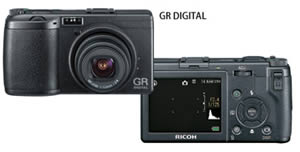Ricoh GR DIGITAL Camera
Ricoh Updated: 2007-07-04Exceptional resolution and low distortion in a single lens unit
Superb image resolution that clearly captures individual hairs. Crisp image quality even in the periphery. These are the proud hallmarks of Ricoh's highly renowned GR Lens, which is breathing new life into digital photography. As illustrated by the MTF curves below, the GR Lens (F2.4, f=5.9mm, equivalent to 28mm focal length on 35mm film camera) compensates for various aberrations, as well as weaker light in the periphery to deliver high-resolution, high-contrast reproduction over the entire image. This exceptional optical performance is ideal for pan-focus, wide-angle photos and empowers users in all shooting environments by providing sharp images with natural color even when the aperture is fully open. With its standout performance and unique personality, this new GR Lens is worthy of inheriting the GR name.
Retractable 5-group 6-lens unit showcases original Ricoh technology
The GR Lens fully compensates for aberrations throughout the wide 28mm field of view by employing six high-quality optical glass lenses in five groups with a special low dispersion lens and two molded aspherical lenses. Multi-coated lens surfaces help direct all wavelengths toward the image sensor for maximum lens brightness, and a large maximum aperture of F2.4 enabled Ricoh to strike a fine balance between large lens diameter and compact dimensions. The original, space-saving design of this retracting lens system combines with a micro-precision drive to enable housing of the high-performance 28mm equivalent lens unit within a slender 25mm body.
Beautiful blurred backgrounds through seven aperture blades
Fine-tuning of the aperture between F2.4 and F9 settings is possible in 1/3EV step increments, allowing photographers to adjust depth of field and achieve beautiful blurred backgrounds whenever desired. The quality of blurred backgrounds is especially high because seven aperture blades (an odd number) form a nearly circular lens iris not only when the aperture is fully open, but also when the aperture is nearly closed.
GR Lens advantages bring out high-resolution CCD potential
Ricoh's advanced CCD delivers signature GR image quality. This compact 1/1.8-type imaging sensor with approximately 8.13 million effective pixels fully complements the sharp GR Lens to produce images with rich gradations and a wide dynamic range. Results are truly gratifying even when shooting at high sensitivity settings up to ISO1600.
Color aberration correction eliminates purple fringes
One of the most common color aberrations faced by digital photographers is a chromatic aberration called a “purple fringe” that appears along high-contrast edges. This problem becomes more pronounced when using a wide-angle lens and fully open aperture. But highly efficient color aberration correction functions in the GR Digital eliminate purple fringes and reproduce true-to-life images in vivid, fine detail and natural color.
Newly developed GR Engine reproduces true-to-life images
The GR Engine was developed with the goal of reproducing images that match or surpass film camera photographs in terms of resolution and color faithfulness. Its sophisticated image processing algorithm, developed through analysis of massive sample image data, produces natural results in nearly all shooting conditions. Even diagonal lines, which are a challenge for CCD sensors, are reproduced smoothly thanks to an original image correction process in Ricoh's GR Engine. By intelligently analyzing shooting conditions and user intentions, Ricoh's new GR Engine produces exceptionally pleasing true-to-life results.
Meticulously screened components sharply reduce noise
Grainy electronic noise, especially in shadows, is a problem inherent to digital cameras. Ricoh minimizes such noise at its source by only employing electronic components, such as circuit boards, that have been proven through rigorous screening to offer excellent low-noise characteristics. This low-noise internal circuitry together with advanced digital noise reduction helps ensure superb image quality that is worthy of the GR moniker.
Brochure PDF GR DIGITAL
English GR DIGITAL Operation Manual
France GR DIGITAL Operation Manual
Deutsch GR DIGITAL Operation Manual
Italiano GR DIGITAL Operation Manual
Espanol GR DIGITAL Operation Manual
GR DIGITAL Operation Manual Errata 1
GR DIGITAL Operation Manual Errata 2
Related Manuals
Ricoh Caplio GX100 Digital Camera
Ricoh Caplio GX8 Digital Camera
Ricoh Caplio GX Digital Camera
Ricoh Caplio R40 Digital Camera
Ricoh Caplio R30 Digital Camera
Ricoh Caplio R6 Digital Camera
Ricoh Caplio R5 Digital Camera
Ricoh Caplio R4 Digital Camera
Ricoh Caplio R3 Digital Camera
Ricoh Caplio R2 Digital Camera
Ricoh Caplio R1V Digital Camera
Ricoh Caplio R1 Digital Camera
